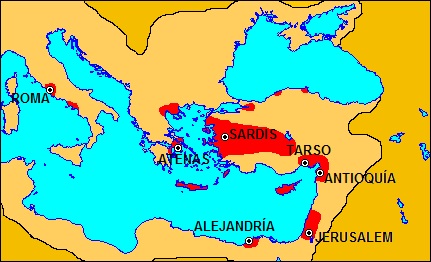Note of the Editor:
The city Antioch, ‘the cradle of Christianity’ was a melting-pot town that played a central role in the emergence of both Hellenistic Judaism and early Christianity. Evropa Soberana mentions that Luke the Evangelist was from Antioch, and when writing about St. Ignatius of Antioch, a subversive ideologue thrown to the lions by the Romans, Soberana adds: ‘It is interesting to pay attention to the names of the preachers since they always come from the mongrelised areas: eastern and Judaised’.
 Left, one of the maps that appear in Soberana’s PDF (Caption: ‘The extension of Christianity around the year 100. Note that the areas of Christian preaching coincide with the densest Jewish settlement areas’). Also remember that, right after Julian was assassinated, a Christian emperor ordered the burning of the Antioch library that had been founded by Julian: a library that presumably contained documents showing the true origins of Christianity.
Left, one of the maps that appear in Soberana’s PDF (Caption: ‘The extension of Christianity around the year 100. Note that the areas of Christian preaching coincide with the densest Jewish settlement areas’). Also remember that, right after Julian was assassinated, a Christian emperor ordered the burning of the Antioch library that had been founded by Julian: a library that presumably contained documents showing the true origins of Christianity.
Below, an abridged translation from the first volume of Karlheinz Deschner’s Kriminalgeschichte des Christentums (Criminal History of Christianity):
______ 卐 ______
Antioch
For a long time the divisions had split the great patriarchal seat of Antioch. The current Turkish Antakya (28,000 inhabitants, including 4,000 Christians) does not reveal what it once was: the capital of Syria, with perhaps 800,000 inhabitants, the third largest city in the Roman Empire—after Rome and Alexandria—, the ‘metropolis and eye’ of the Christian East.
Located not far from the mouth of the Orontes in the Mediterranean, built majestically by the ostentatious Syrian kings, famous for its luxurious temples, churches, arcaded streets, the imperial palace, theatres, baths and the stadium, an important centre of military power, Antioch played a great role in the history of the new religion from the beginning.
It was the city in which the Christians received their name from the pagans; the city in which Paul preached and already entered into conflict with Peter; where Ignatius stirred the spirits, and where the theological school founded by Lucian, the martyr, taught his teachings, representing the ‘left wing’ in the Christological conflict, and marked the history of the Church of that century, although most of the members of the school (even John Chrysostom) were accused of heresy throughout their life or part of it, especially Arius.
Antioch was a place of celebration of numerous synods, especially Arian synods, and more than thirty councils of the old Church. It was here where Julian was residing in the years 362-363 writing his Against the Galileans; where John Chrysostom ‘saw the light of the world’. Antioch became one of the main bastions of the expansion of Christianity, ‘the head of the Church of the East’ (Basil) and seat of a patriarch who in the 4th century ruled the political dioceses of the East: fifteen ecclesiastical provinces with more than two hundred bishoprics.
Antioch was full of intrigue and turmoil, especially since the Arians had deposed the patriarch Eustochius, one of the most passionate apostles of the Nicene doctrine, for ‘heresy’ because of his immorality and his rebellion against Emperor Constantine, who banished him until his death.
However, at the time of the Meletian schism, which lasted fifty-five years, from 360 to 415, there were three suitors who fought among themselves and who tore at their disputes both the Eastern and the Western Church: Paulinians (fundamentalists) followers of the doctrine of Nicaea, semi-Arians and Arians.